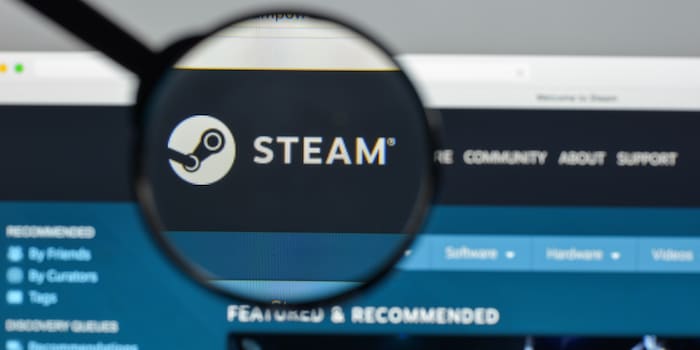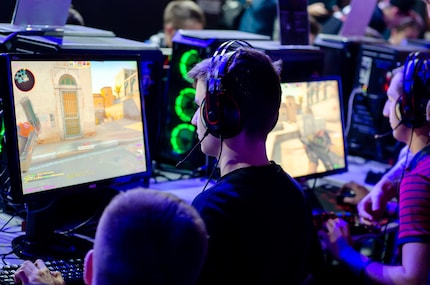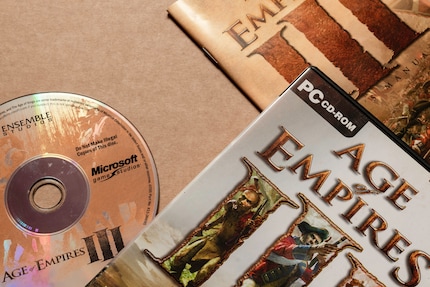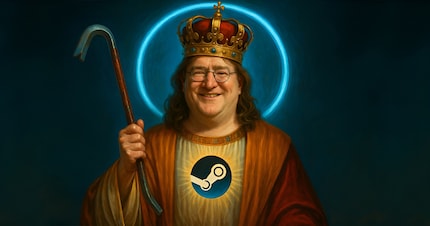

Valve – the world’s most unconventional billion-dollar company
A private corporation with no investors, no hierarchies and almost no competition – yet it’s one of the most profitable companies in the world. Valve revolutionised the PC market with its Steam platform, building an ecosystem that has kept gamers hooked for two decades.
Which company pops into your mind first when you think of tech giants? Certainly Apple, Google or Microsoft. But in the gaming sector, there’s one quiet giant that surpasses them all. At least in its reach and effect: Valve. The company has no investors, no hierarchies, puts on no press conferences. And yet, it controls the largest digital games market in the world – Steam.
I’ve been using Steam myself for years, and wondered recently: how did a handful of developers from small-town Bellevue in north-western Washington state, USA build one of the strongest brands in the industry? All without a hint of traditional corporate structures?
Valve and Steam: the foundation of modern PC gaming
Valve is the company behind Steam, the platform hosting almost every PC game sold today. There’s even a few Mac games! Founded in 1996 by two former Microsoft employees, Valve initially won acclaim for games such as Half-Life and Counter-Strike. However, everything changed with the launch of Steam in 2003: a humble developer studio became a global platform operator in just a few years. Steam is a digital vendor, community hub, update system and marketplace for virtual items. The backbone of modern PC gaming, so to speak. Today, Steam is synonymous with computer gaming. And Valve, the company behind it, has become an economic and cultural phenomenon.

Source: Shutterstock
How did Valve grow so powerful?
Around 132 million people use Steam every month, 69 million every day. In early 2025, Steam broke a new record with over 40 million simultaneous active users.
For two decades, millions of gamers have built up massive games libraries there – often spanning several hundred titles. In comparison, my few dozen games make me a very small fry. Some players also invest hundreds, even thousands of francs into public profiles. This creates an emotional and financial bond: once you’ve invested that much into Steam, you won’t switch platforms.
And Valve pockets a sum from every transaction: 30 per cent commission on games, in-game purchases and virtual items. This margin is so lucrative that major publishers such as EA, Ubisoft and Activision all tried founding their own platforms in order to free themselves. But try is all they could do; after a few years, all of them returned to Steam. You don’t even need EA’s platform for the newest Battlefield. Like all other games publishers, EA has had to realise that gamers want to stick with Steam. Although Steam isn’t an official monopoly, it is the de facto industry standard. No other platform has managed to build up a similarly massive and active user base, all while appearing trustworthy as ever.
Image questions
As Steam grows in size and power, so does criticism of it. Of course, developer studios large and small depend on the platform. In 2024 alone, 14,000 new games appeared on Steam, many of them unfinished, of questionable quality or even fraudulent. Developers want to make a quick buck with these so-called asset flips – and they succeed time and again. Steam’s rating system has also been criticised as susceptible to manipulation. Central here is review bombing, or when a game is trashed en masse. This happened to Helldivers II, for example, when Sony wanted to enforce an account requirement. True, this could be viewed as encouraging community power. If enough people get together, they can even initiate campaigns against some games.
However, there are regular complaints about the toxic nature of many forums and comments sections. Moderation is very limited, and insults are almost expected with millions of comments posted every day.
It’s also interesting to note that it’s nearly impossible for users to resell their games purchased digitally on Steam. You don’t actually own your game in the classic sense, only a transferable licence exclusively bound to your Steam account. A court in France already ruled this illegal back in 2019. Nevertheless, Valve hasn’t implemented any changes yet, despite repeated demands by the community.
Steam as a role model for iTunes and Spotify
Before Steam, gaming was still analogue. If you wanted a new release, you went to an IRL store or ordered from Digitec. Games came in a box with a CD or DVD inside. You installed the game and kept the disc safe – without one, games often wouldn’t start at all. I’m sure older readers remember it all.
But when Valve released Steam in 2003, the market radically changed. Originally intended as a platform for distributing updates for Counter-Strike and Half-Life, Steam quickly grew into a digital distribution system – the first of its kind on a large scale. Players could buy their titles online, download them and save them permanently in a library, without any physical data carriers. The concept was initially controversial. Many gamers mistrusted the idea of only owning software digitally. But over time, the convenience, automatic updates, cloud storage and special deals won many over. And of course, without Steam there’d be no Counter-Strike or Half-Life.
Valve did the same thing Spotify and Apple (the latter with iTunes) did on the music market – digitising ownership. Today, purchasing physical games has virtually disappeared in the PC gaming sector. Hardly any modern computers still have a disc drive. So, Steam isn’t just a pioneer of digital distribution, but a trailblazer for a new consumer culture as well: games are available at any time, can be installed with just a few clicks, and updates arrive automatically in the background. The model also makes more ecological sense, as long as data centres are powered by electricity from renewable sources. Digital distribution without plastic discs and global shipping is more efficient, more convenient and more profitable in the long term – for gamers, developers and above all for Valve itself.

Source: Shutterstock
Valve’s business model – simple and impressive
Steam follows a simple formula: Valve provides the platform, takes care of distribution, updates, community, cloud storage and payment processing, and collects a commission between 20 and 30 per cent. For developers, this means no paying for storage, no retail sales, no high marketing costs. Even small indie studios can debut their games to 69 million daily users. The Steam community helps small independent developers land smash hits.
And Valve? It earns a commission on every transaction. At minimal costs: server, support, development. In March 2025 alone, Valve earned 82 million US dollars from virtual keys for loot boxes in Counter-Strike 2. In a single month. On top of that, it charges a 10-per-cent marketplace fee on every skin sale. The system resembles a closed economic cycle, where every transaction yields revenue several times over without any real production costs.
What makes Valve unique
If you look at the company’s history, it’s clear that Valve made the right choices. Valve became a titan through its passion for game development. Titles such as Half-Life, Portal and Counter-Strike are considered milestones in video game history and are still unrivalled today. Just look at Counter-Strike to see how Valve thinks. A fan mod for Half-Life became so popular that Valve realised it could make money off it.
Other studios would’ve taken legal action against any mods. But what did Valve do? Yes, it bought the rights, hired the developers of Counter-Strike and turned it into one of the most successful games ever. This openness to innovation and community contributions still characterises Valve today. Content such as skins, maps and mods are made almost exclusively by the community. Initial creation, playtesting, reviewing – it’s all individual gamers. Valve only curates what works. This reduces internal costs and gets fans more involved. Valve hardly lifts a finger and still gives customers what they want.
What makes Valve special
Valve isn’t a listed public company. Instead, it’s still owned by founder Gabe Newell, now 63 years old, and several longstanding employees. According to estimates, Valve generated around 13 billion US dollars in revenue in 2021, the majority of this coming from Steam. This one platform alone is responsible for around 10 to 11 billion US dollars. More up-to-date figures are hard to find. If at all, leaks are the only way to learn about how Valve’s doing.
But it’s precisely this lack of transparency that strengthens trust. To many, founder Gabe Newell isn’t a classic CEO, but a gamer – «one of us». He never brought investors on board, and this is exactly what gives Valve a decisive advantage. No quarterly figures, no pressure to grow, no shareholder noise. Valve can afford to think long-term or simply remain silent if there’s nothing new to say.

Source: Wikimedia Commons
Corporate culture: working without bosses
Internal life at Valve is almost legendary, and was openly described in the Valve New Employee Handbook: any hierarchies are radically flat. There are no managers, no traditional superiors, no fixed job titles. Employees decide for themselves what they work on. Tables have wheels on them so that teams can physically move closer together. Projects emerge spontaneously, and if you have a good idea, you look for buddies to bring on board. There are no departments, but rather cabals, i.e. self-founded, multidisciplinary teams.
Mistakes are expressly permitted. Failure is seen as a learning opportunity, not a career killer. Here’s how the handbook puts it:
Nobody has ever been fired at Valve for making a mistake. Providing the freedom to fail is essential to our culture.
This freedom works because Valve is uncompromising when it comes to recruitment. Only so-called T-shaped people are hired – people with broad knowledge but deep expertise in one area. Every new employee must be «capable of literally running this company», as they put it. Performance is assessed via peer reviews, not by superiors. Employees assess each other and thus also determine salaries. The result: a culture that demands responsibility, self-motivation and mutual respect – something that many companies preach but don’t practise. Valve doesn’t just parrot empty platitudes, it walks the walk.
Are all employees happy with it? Well, you do get repeated reports from former Valve employees who describe the lack of leadership as a problem. The idea may have worked when the company was smaller, as one hardware engineer reports. But with over 300 employees, this idealised vision has seemingly reached its limits. Dealing with troublemakers if they show up is apparently tricky. In addition, employees reportedly prefer rushing into projects that’ll earn them high bonuses at the end of the year.
Economic viability: billions with just 300 people
With an estimated 300 employees and billions in sales, Valve is an economic anomaly: no investors, no marketing apparatus, no classic corporate structure. And yet (or precisely because of this), it’s extremely profitable. According to documents from a data leak, Valve already made a profit of around 1.2 billion US dollars in 2021 with around 336 employees. This corresponds to a profit of more than 3.5 million US dollars per employee – a figure that even tech giants such as Google or Microsoft can’t reach. The reason: Steam scales perfectly in the digital space. Each new user barely generates costs, but always increases sales. The platform has become a surefire success.
No competition to speak of
Attempts to rival Steam have so far failed. The Epic Games Store, for example, offered free blockbuster titles, exclusive releases and lower sales fees. It charges 0 per cent on the first million sales per product and 12 per cent after that – instead of 30 per cent off the bat as Steam does. But in 2024, it still only achieved a turnover of 1.09 billion US dollars, a fraction of what Valve makes.
Major publishers such as EA, Ubisoft and even Activision have had to realise that their own platforms don’t stand a chance against Steam. What’s more, they simply can’t afford to miss out on this market share. Steam’s strength lies in its ecosystem and user base, which has been around for decades. Steam is more than just a store, it’s also a social network for gamers and therefore practically irreplaceable for many of them.
A closed ecosystem: hardware and exclusive titles
Valve doesn’t just control its platform, but central components of the whole ecosystem too, from hardware to exclusive games. While other publishers offer their titles on all possible platforms, Valve binds its greatest successes only to Steam. Some games can only be played there. Games such as DotA 2 or Half-Life: Alyx aren’t just blockbusters, they’re the bedrock of platform loyalty. Millions of players log in every day for these games alone, keeping them in the Steam universe automatically. And with the introduction of the Steam Deck, Valve only extended this idea to its hardware. The handheld is basically a portable PC that runs Steam natively. It opens up access to your entire library – on the move, without a cloud subscription, at no extra cost.

It appears Valve has achieved something that even massive console manufacturers can’t manage. Its own hardware functions as an extension of the existing ecosystem, not a competing product. However, sales are still below expectations.
The Steam Controller and Valve Index VR goggles also follow this principle: they serve as a physical bridge into the digital world of Steam, further consolidating the company’s independence. For comparison, even big PlayStation exclusives often appear on Steam after a certain delay.
While other publishers distribute their content, Valve is building a closed universe that encompasses everything from game idea to input device, strengthening its market position this way year after year.
SteamOS – Valve’s silent attack on Windows
With SteamOS, Valve has created more than just basic software for the Steam Deck. The Linux-based operating system combines the simplicity of a console with the openness of a PC, aiming to compete with Windows in the gaming sector in the long term.
SteamOS is open-source and designed top to bottom for gamers. The Steam client serves as a user interface for your library, cloud, chat and recording features, while desktop mode provides access to the Linux substructure. Thanks to the Proton compatibility layer developed by Valve, tens of thousands of Windows games can now run on SteamOS – many of them don’t even need customisation by developers.
Rumours suggest that a desktop version for all PCs could soon be released too. This’d allow Valve to shake up not only the market for gaming hardware, but operating systems in general. But SteamOS isn’t perfect yet – some anti-cheat systems and hardware configurations are causing problems. Still, the system is developing rapidly. Should Valve take the step towards a fully fledged PC operating system, SteamOS could become for gaming what Steam once was for digital distribution: a revolution.
In conclusion
Valve remains a mystery. The company only speaks when it really has something to say. This silence isn’t carelessness, but purely strategic. While other tech giants chase headlines, Valve works quietly and earns billions. It’s completely contrary to traditional corporate logic: no bosses, no investors, no hierarchy. And yet, it works better than almost any other company in the industry. Gabe Newell has created something that’s very rare in business: a system based on freedom, responsibility and trust. A company that proves you can be large, profitable and independent. Who doesn’t care about market investors.
But despite all the fascinating aspects, one thing can’t be forgotten: Valve can afford to act how it does. With billions in reserves, a platform dominating the market and a loyal community, the company operates from a position of near unassailable strength.
Critics complain that Valve is going mad with power – for example, through its 30 per cent commission, which many developers have felt is too high for years. Their lack of transparency surrounding sales figures and moderation on Steam is also regularly criticised. Nevertheless, Valve remains one of one. And maybe that’s Valve’s biggest lesson: sometimes, the most radical business model is simply to work differently.

Source: AI/Gagadet
Cool: Creating interfaces between the real world and the world of pure information. Not cool: Driving by car to the mall to shop. My life happens online, the information age is where I feel at home.
Interesting facts about products, behind-the-scenes looks at manufacturers and deep-dives on interesting people.
Show all


